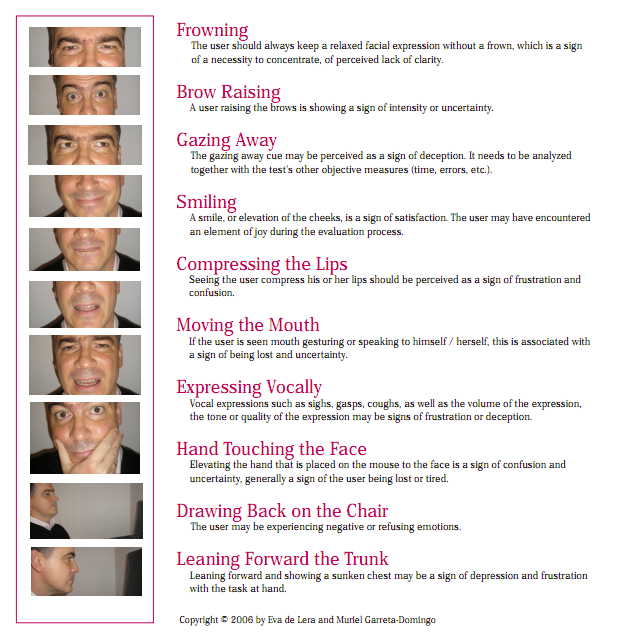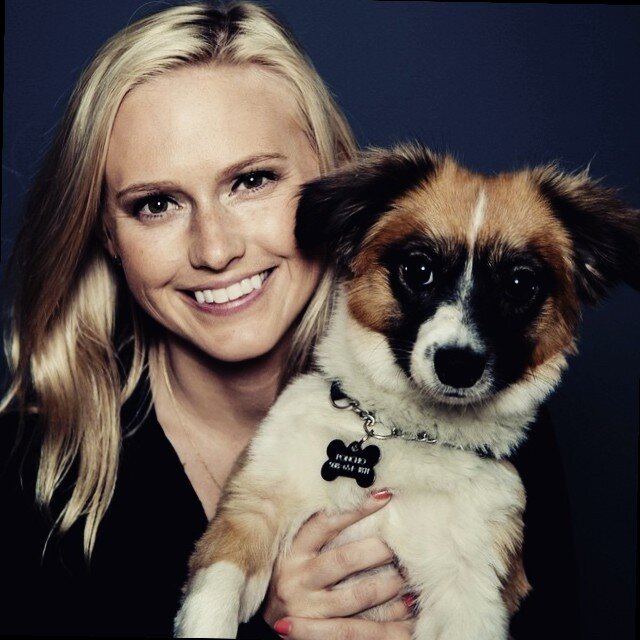Ten emotion heuristics: how to read a participant’s body language

As user researchers, we take words very seriously and place most of our importance on what our users are saying. While this is, in fact, where our attention should be placed, we should also consider the body language of our users during our research sessions. I’m not talking about “rage-clicking” or clear sighs of frustration (although those are important too), but more of the subtle body language.
A while back, I wrote about how important a user researcher’s body language is during an interview, and now I want to write about the other side: the user’s body language.
Why is this important?
One of the number one principles (at least one of mine) of user research is:
watch what users do versus just listening to what they say
When we focus all of our attention on what people are saying, we can miss what they are actually doing. And, unsurprisingly, what people say and what they do can be quite different.
I have a perfect example of this. I was conducting usability tests on a new flow we were thinking about implementing. One of the main tasks our users had to do was download multiple images at once. We didn’t make this easy and, previously, our users would have to hack downloading them at once. Once we finally had the resources to tackle this project, I was super excited to test our ideas.
We had one idea in particular we thought was a sure winner. I couldn’t wait to test it with users. We showed it at about ten usability tests and, luckily, I had my observation mindset on. Many of the users said they really liked it. They could finally download multiple images at once. HOWEVER, the majority of users, while telling me that they liked it, struggled with understanding the flow and completing the tasks. In fact, three users clicked on many different areas and appeared visibly frustrated, but still said it “wasn’t bad.”
Had I just been listening and using words as data, I would have pushed forward this idea. Instead, I noticed the struggles. During the interview, I was able to dig deeper into the frustrations beyond the surface. This allowed us to better understand where we needed to improve the UX.
It was after that particular test I started looking more into how to observe user’s behavior and body language during research interviews. I wanted more than retrospective or current self-reporting measures. I searched and found a method that relies on real-time observation of behavior and coding of participants’ facial expressions and gestures. Its creators, Eva de Lera and Muriel Garretta-Domingo call their method the “Ten Emotion Heuristics.”
The Ten Emotion Heuristics:
The heuristics are a set of guidelines to help assess what a user is feeling beyond self-reported measures. As mentioned above, there are times where users actions and words do not match up, and you can use the below heuristics as a way to understand what the user is really feeling, beyond the feelings they may be aware of.
- Frowning. If a user is frowning, it can be a sign of a necessity to concentrate, displeasure or of perceived lack of clarity
- Brow Raising. When users raise their brows, it can be a sign of uncertainty, disbelief, surprise, and exasperation. While surprise isn’t always negative, we don’t necessarily want our users to be surprised or uncertain of the experience on our platform
- Gazing Away. When a user gazes away from the screen, they may feel deceived, ashamed, or confused. They could also very possibly be bored with what is on the screen in front of them
- Smiling. A smile is a sign of satisfaction in which the user may have encountered something satisfying or joyful
- Compressing the Lip. Seeing a user compress their lips is a sign of frustration and confusion. I see this a lot when a user intends to do something, but it does not work, causing frustration and anxiety
- Moving the Mouth. If the user is speaking to themselves, trying to understand or complete a task, this indicates them feeling confused or lost in the experience
- Expressing Vocally. Vocal expressions such as sighs, gasps, coughs, as well as the volume of the expression, the tone or quality of the expression may be signs of frustration or deception.
- Hand Touching the Face. If a user is touching their face during the interview, they could be tired, lost, or confused. This can also indicate a high level of concentration and frustration with a task.
- Leaning Back on the Chair. When a user (or anyone, really) leans back in a chair, it is an indication they are having a negative emotion and would like to remove themselves from the situation. This generally shows a fairly high level of frustration
- 10. Forward Leaning the Trunk. Leaning forward and showing a sunken chest may be a sign of difficulty and frustration with the task at hand. At this point, the user may be close to giving up on a task or experience.

How to use these heuristics
The great thing about the ten emotion heuristics is that they are all 100% observable and cost-effective. The best thing you can do while learning these is to practice. Here is how I have learned to incorporate the emotion heuristics in every one of my interviews. These don’t have to be done step-by-step, but could be thought of that way!
- Memorize the different heuristics
- Practice the heuristics with others — both doing them and observing them
- While practicing with others, write down which heuristics you observe and compare notes
- Record each of your participants and assess heuristics AFTER the interviews — compare notes with a colleague on what heuristics you both found and at what points
- Observe and make note of heuristics during the interviews. See if you can dig deeper during those. Assess the interview after as well to see if you were accurate
- Rinse and repeat until you feel confident observing and noting the heuristics in real-time
Some things to note while you are practicing:
- Always record your participants during the interviews. Even when you are a “pro,” you might miss some instances. Make sure you can see their facial expressions in the recording!
- Have a colleague with you to compare notes (especially in the beginning)
- Take it slow! You won’t learn or notice these all over a short period of time
What can we do with this information?
There are a few different ways I like to use the emotion heuristics, and they all have really benefited my analysis of research studies.
- Observing behavior over words. What people tell you and how they act can be different. The emotion heuristics can give you an indicator of how someone is really feeling at a given moment
- Some negative emotion heuristics appear outside of the concepts that we are testing. This helps give an indication of where we might need to improve the overall user experience of the product, outside of what we are testing
- You can measure if there are trends with certain emotion heuristics across the experience. Are the majority of participants exhibiting particular emotions during one task or flow?
- If many negative emotion heuristics are surfacing during a task, flow, or experience, you can prioritize fixing that issue higher than others
- By identifying the different cues across the interview, you can rate whether the participant’s experience was overall positive or negative.
- Give scores to tasks and overall experiences, which can help with calling attention to issues and prioritization
Although it might sound simple, using these emotion heuristics can be quite tricky. You might get a participant who doesn’t display many expressions or a participant who displays too many at once to count. User research isn’t an exact science and you will never get the perfect participant. The best you can do is practice and observe these signals participants are putting out. They won’t be the answer to all your questions and, sometimes, they may lead you down the wrong path, but they are another tool to put in the user research toolbox.
—
If you liked this article, you may also find these interesting:
- ACV Laddering in UX Research: A simple method to uncover the user’s core values
- User Research Isn’t Black & White and how to navigate the grey area
- Benchmarking in UX Research to test how an app or website is progressing over time
- How to Assess Your Research Interviews: A framework to continuously improve
If you are interested, please join the User Research Academy Slack Community for more updates, postings, and Q&A sessions :)
